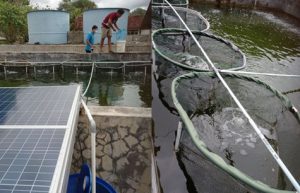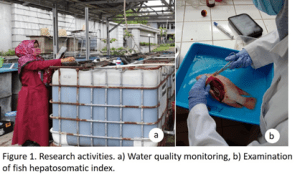Head of Laboratory: Indah Istiqomah, S.Pi., M.Si., Ph.D.
Members:
- Prof. Dr. Ir. Rustadi,M.Sc
- Dr. Ir. Ign. Hardaningsih, M.Si.
- Dr. Ir. Bambang Triyatmo, M.P.
- Ir. Sukardi, M.P.
- Dr. Susilo Budi Priyono, S.Pi., M.Si
- Dr. Senny Helmiati, S.Pi., M.Sc.
- Dr. Dini Wahyu Kartika Sari, S.Pi., M.Si.
Introduction
Aquaculture Laboratory is an educational and research laboratory for undergraduate, master, doctoral students and researchers. We focus on sustainable tropical aquaculture. We develop technology and management for aquatic organisms aquaculture by optimizing the fish physiology, microbiomes, genetics, feed, water quality, technical, and economics aspects to produce efficient, profitable, and environmentally-friendly aquaculture technology.
We study freshwater commodities such as tilapia (Oreochromis sp.), tropical eel (Anguilla bicolor and A. marmorata), goramy (Osphonemus gouramy), catfish (Clarias sp.), Tawes (Puntius japonicus), giant prawn (Macrobrachium rosenbergii), carp (Cyprinus carpio), ornamental fish, etc. (Fig. 1). We also study commodities of brackish water (Pacific white shrimp, Litopenaeus vannamei) and mariculture such as grouper (Epinephelus spp.), barramundi (Lates calcarifer), abalone (Haliotis squamata), and seaweed (Fig 2).
 Fig 1. Freshwater species in laboratoy of aquaculture. A. Tilapia (Oreochromis sp.), B. Catfish (Clarias sp.), C. Tropical eel (Anguilla bicolor), D. Guppy (Poecilia reticulata) and Goldfish (Carassius auratus).
Fig 1. Freshwater species in laboratoy of aquaculture. A. Tilapia (Oreochromis sp.), B. Catfish (Clarias sp.), C. Tropical eel (Anguilla bicolor), D. Guppy (Poecilia reticulata) and Goldfish (Carassius auratus).

Fig 2. Brackish water and mariculture species in laboratory of aquaculture. A. Pacific white shrimp (Litopenaeus vannamei). B. White snapper (Lates calcarifer), C. Grouper (Epinephelus sp.) (B).
Aquaculture laboratory consists of eight units (sub-laboratory), namely:
- Aquaculture unit (Technician: Mr. Kusmanto).
- Fish genetic and breeding unit (Technician: Mr. Artiyo)
- Fish feed and nutrition unit (Technician: R. Budi Santoso)
- Research unit (technician: Mr Kusmanto)
- Mariculture unit (Technician: Mr. Sugiman)
- Brackish water unit (Technician: Mr. Sugiman)
- Semi-outdoor cultivation unit (Technician: Mr. Artiyo)
- Outdoor pond unit (Technician: Mr. Artiyo).
Aquaculture laboratory is equipped with facilities, including cylindrical fiber tubs (24 units) and boxes (75 units), square glass tubs (80 units), square concrete tubs (6 units), square ponds, and floating nets of various sizes, and equipped with an aeration system, heater, recirculation unit, disposal water treatment. Supporting facilities available in the laboratory includes microalgae culture facility (1 unit), proximate analysis equipment (5 units), microscope (10 units), theodolite (3 units), refrigerator (4 units), freezer (4 units), oxygen tank 91 units), water quality checker (DO, pH, salinity, temperature, redox potential; 5 units), fish weight and length measurer (5 units), incubator (2 units), centrifugator (1 unit), analytical balance (2 units), micropipette (10 sets), marine and freshwater quality kit (ammonia, nitrite, nitrate, phosphate), and glassware.
Educational activities
Practical subjects held in the laboratory:
- Laboratory Exercices of Aquatic Plant,
- Practices of Water Quality Management for Aquaculture,
- Practices of Aquaculture Engineering ,
- Practices of Nutrition and Fish Feed Management,
- Practices of Genetics and Fish Breeding,
- Practices of Brackishwater Aquaculture Management,
- Practices of Mariculture Management,
- Practice of Freshwater Aquaculture Management,
- Practices of Fish Hatchery Technology and Management,
- (Practice) Ornamental Fish Cultivation and Aquascape,
- (Practice) Life Feed Culture

Fig 3. Laboratory exercise of bachelor of aquaculture students. A. Fish transportation, B. Fish weight and length sampling, C. Total bacteria monitoring, D. Water salinity test, E. Amonia, nitrite and nitrate tests, F. Shrimp hemolymph collection.
Research activities
Research activities in the aquaculture laboratory are carried out by funding from the government, UGM, and private company partners. Research grants from the government and university include PDUPT, PTUPT, RTA, KRUPT Kemaritiman, Faculty flagship grants, Lecturer research grants, etc. Our collaborative research with UKBAT Cangkringan has succeeded in releasing a superior red tilapia variety from crosses and individual selection named “Nilasa” with fast intergenerational growth performance, survival rate, low feed conversion ratio, disease-resistant characteristics, dressing percentage, and high nutritional value of meat (SK Menteri Kelautan dan Perikanan No.KEP.47/MEN/2012).
We have a good partnership with PT CJ Cheiljedang Feed Semarang (2018 – 2021, national) to investigate the effect of feed formula on the growth, survival, and FCR of catfish. With the collaboration, we also examined the impact of feed formula on growth, survival, FCR, and physiology of pacific white shrimp. Collaboration with PT Sinergi Samudera Biru Batam (National, 2021-present) investigates the effect of feed formula on growth, survival, FCR, and shrimp physiology. The laboratory has also succeeded in developing an aquaponic technology package, a productive giant prawn cultivation system with terraced shelters, a method of estimating the carrying capacity of waters for aquaculture. Aquaculture Laboratory establishing research collaborations with SEARCA (Philippines, International) to develop aquaculture, PT Indokor Bangun Desa (local) to research production dynamics and water quality in shrimp ponds, DIY Fisheries Service (Local) to create superior giant prawns.
Currently, we are designing an efficient water recirculation system for indoor eel cultivation. We utilize autochthonous microbes as biocontrol (probiotics) to improve cultured water quality and growth for tilapia, eel, and white shrimp. Various strains of nitrifying bacteria have been isolated and evaluated on their efficacy in improving the water quality of recirculating aquaculture systems. Activation of autochthonous microbes through regulation of the C/N ratio of waters and provision of prebiotics are also studied in the laboratory.
We are developing functional fish feed and natural feed fermentation technology (foliage) to achieve good digestibility and nutrition for fish. We evaluate several types of local plant-based feed ingredients that have the potential as fish feed ingredients. We have also developed techniques for cultivating natural feed for fish larvae, namely silkworms (Tubifex sp.) and water fleas (Moina sp.).
Genetics and fish breeding unit study mapping the genetics variety and the superior trait of some endemic species, which has an economic potency, such as giant gourami and snakehead fish. Sperm cryopreservation and DNA barcoding for endemic and alien fishes are also our ongoing projects.
Laboratory of Aquaculture explores solar panels, as an efficient energy source, with various internet-connected digital water quality sensors to create efficient and sustainable innovative aquaculture. Solar panel facilities have been applied in white snapper cultivation in floating nets through the maritime research consortium grant from the Kemenristek BRIN 2021 (Indah Istiqomah as a member).
In addition to research activities, community service activities are also conducted by collaboration with the local government, and incidentally with several private parties and SOEs. One of the activities carried out is the facility for water quality monitor and examination. We are waiting for collaboration with various parties!

Fig 4. Indoor recirculating aquaculture system for eel (Anguilla bicolor) and other freshwater species.

Fig 5. Fish feed formulation with plant-based feed ingredients, namely fermented Moringa leaf meal as a substitute for fish meal in red tilapia feed.

Fig 6. cultivation technology of Daphnia sp. using catfish culture waste media.

Fig 7. Klebsiella sp. A3, a non-pathogenic simultaneous nitrifying-denitrifying heterotrophic bacteria isolated from tilapia earthen pond.

Fig 8. Solar panel-powered white snapper (Lates calcarifer) culture in nets with recirculating aquaculture system (RAS).
Doctoral Research Activities

Doctoral Student Eny Heriyati (2017-2022) |
Research topic: Carrying Capacity Improvement of Red Tilapia (Oreochromis Sp.) Culture using Technology Microbubble in A Recirculating System
Supervisor: Prof. Ir. Rustadi, M.Sc, Dr. Ir. Alim Isnansetyo, M.Sc., dan Dr. Ir Bambang Triyatmo, M.P.
Scholarships: 1. Beasiswa Pendidikan Pascasarjana Dalam Negeri (2017-2020) 2. Beasiswa Pemda Kaltim (2019) 3. Hibah Rekognisi Tugas Akhir 2020 |
Dr Eny Heriyati studies the effect of microbubble aeration on the dissolved oxygen (DO), growth performance, health status, immune response and to determine the the carrying capacity to red tilapia cultivation. Her research was divided into three stages. She tested the performance of the type of aeration device, the effect of microbubble aeration compared to blower in increasing DO, growth, fish physiology and fish resistance to stresors, and the effects of microbubble aerator on the growth and physiology of red tilapia at different densities. The equipment used in her research were an orifice and porous pipe microbubble aerator with one nozzle unit, blower aerator, and gas flow meter. Water quality checker was used to measure daily water quality. Water quality parameters such as CO2, alkalinity, BOD, ammonia, nitrite, nitrate were measured tetrimetrically. Hemoglobin, hematokrit and glucose levels were measured using a digital automatic analyzer, The white blood cell count used turk’s solution, total red blood cells were analyzed using Hayem’s solution, total plasma protein was carried out based on the colorimetric method using the Bradford Protein Test Kit solution, and plasma cortisol was measured by ELISA. Parts of her research results have been published in the journal of AACL Bioflux 14(5).2021 ( http://www.bioflux.com.ro/docs/2021.3006-3022.pdf ), and accepted in the international journal WJST Volume 9 (2022).



